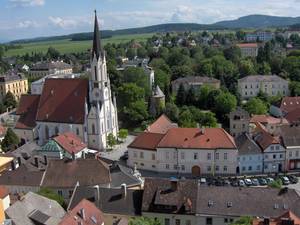Melk

The Lower Austrian township of Melk lies 80 km west of Vienna on the right bank of the Danube, in the Valley of Wachau, UNESCO world heritage area.
Signs of early settlement reach back to the Neolitic, today the town has about 5000 inhabitants. It is best known as the site of a massive baroque Benedictine monastery, the Melk Abbey.
The first written reference of Melk as “Medilica”dates back to 831, it is also mentioned in the “Nibelungenlied” (“Song of the Nibelungs”) as “Medelike”. The Babenberg margraves Leopold I (time of reign 976-994), Henry I (period of reign 994-1018) Adalbert the Victorious (1018-1055) resided in the castle of Melk. Their regency is strongly connected with the formation of Österreich (Austria), first mentioned in the famous “Ostarrichi” document of 886, as far as we know.
The territory assigned to the Babenberg margraves initially reached from the Enns to the area today called Wienerwald, and belonged to the Duchy of Bavaria until 1156. The Babenbergs successively moved east, to Tulln, Klosterneuburg, and finally to Vienna.
In 1089, margrave Leopold II called Benedictine monks to Melk, who up until today are acting there under their well-known motto of “Ora et labora et lege”. Today’s abbey gymnasium developed from the monastery’s school from the 12th century, and is one of the oldest schools of Austria.
The most important site of Melk is the Benedictine monastery, the Abbey of Melk. It is situated on a hill high above the Danube, and is the biggest monastery of the Austrian baroque aera. Since 1451, on October 13th there is a yearly celebration called the “Kolomanikirtag”, commemorating the patron of the town and the Abbey. On the market there is the “Kolomanibrunnen”, a fountain from 1689. In the Abbey of Melk every year at Whitsunday the International Baroque Celebration takes place with concerts, and in July and August the Summer Festival in the Danube Arena. Rallycross championships at the “Wachauring” count among the summer sport attractions, but also bicycling on the bikeways along the Danube.
A memorial reminds of the 5000 people who died 1944-1945 in a satellite camp of Mauthausen on the area of the Birago barracks in Melk. Another memorial reminds of the 300 Russian prisoners, who were victims of a fire in 1805 in the Abbey.
Sources:
www.melk.gv.at; http://de.wikipedia.org/wiki/Melk
Image source:
commons.wikimedia.org/wiki/File:Melk36.jpg





